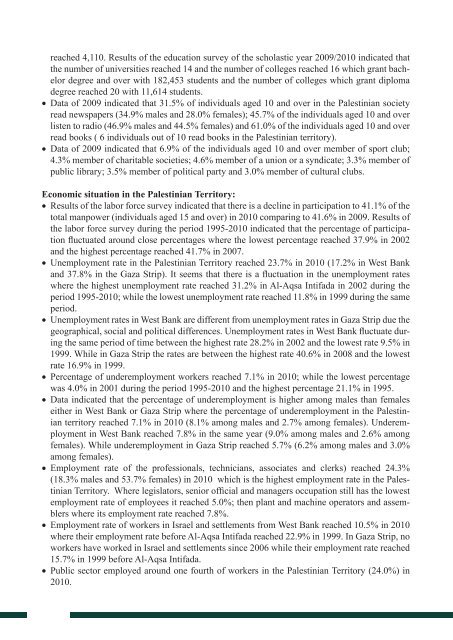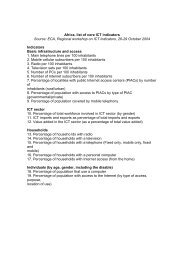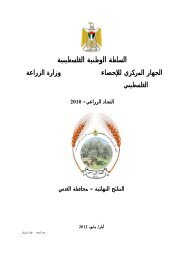A special bulletin on the Palestinians - Palestinian Central Bureau of ...
A special bulletin on the Palestinians - Palestinian Central Bureau of ...
A special bulletin on the Palestinians - Palestinian Central Bureau of ...
You also want an ePaper? Increase the reach of your titles
YUMPU automatically turns print PDFs into web optimized ePapers that Google loves.
eached 4,110. Results <strong>of</strong> <strong>the</strong> educati<strong>on</strong> survey <strong>of</strong> <strong>the</strong> scholastic year 2009/2010 indicated that<strong>the</strong> number <strong>of</strong> universities reached 14 and <strong>the</strong> number <strong>of</strong> colleges reached 16 which grant bachelordegree and over with 182,453 students and <strong>the</strong> number <strong>of</strong> colleges which grant diplomadegree reached 20 with 11,614 students.• Data <strong>of</strong> 2009 indicated that 31.5% <strong>of</strong> individuals aged 10 and over in <strong>the</strong> <strong>Palestinian</strong> societyread newspapers (34.9% males and 28.0% females); 45.7% <strong>of</strong> <strong>the</strong> individuals aged 10 and overlisten to radio (46.9% males and 44.5% females) and 61.0% <strong>of</strong> <strong>the</strong> individuals aged 10 and overread books ( 6 individuals out <strong>of</strong> 10 read books in <strong>the</strong> <strong>Palestinian</strong> territory).• Data <strong>of</strong> 2009 indicated that 6.9% <strong>of</strong> <strong>the</strong> individuals aged 10 and over member <strong>of</strong> sport club;4.3% member <strong>of</strong> charitable societies; 4.6% member <strong>of</strong> a uni<strong>on</strong> or a syndicate; 3.3% member <strong>of</strong>public library; 3.5% member <strong>of</strong> political party and 3.0% member <strong>of</strong> cultural clubs.Ec<strong>on</strong>omic situati<strong>on</strong> in <strong>the</strong> <strong>Palestinian</strong> Territory:• Results <strong>of</strong> <strong>the</strong> labor force survey indicated that <strong>the</strong>re is a decline in participati<strong>on</strong> to 41.1% <strong>of</strong> <strong>the</strong>total manpower (individuals aged 15 and over) in 2010 comparing to 41.6% in 2009. Results <strong>of</strong><strong>the</strong> labor force survey during <strong>the</strong> period 1995-2010 indicated that <strong>the</strong> percentage <strong>of</strong> participati<strong>on</strong>fluctuated around close percentages where <strong>the</strong> lowest percentage reached 37.9% in 2002and <strong>the</strong> highest percentage reached 41.7% in 2007.• Unemployment rate in <strong>the</strong> <strong>Palestinian</strong> Territory reached 23.7% in 2010 (17.2% in West Bankand 37.8% in <strong>the</strong> Gaza Strip). It seems that <strong>the</strong>re is a fluctuati<strong>on</strong> in <strong>the</strong> unemployment rateswhere <strong>the</strong> highest unemployment rate reached 31.2% in Al-Aqsa Intifada in 2002 during <strong>the</strong>period 1995-2010; while <strong>the</strong> lowest unemployment rate reached 11.8% in 1999 during <strong>the</strong> sameperiod.• Unemployment rates in West Bank are different from unemployment rates in Gaza Strip due <strong>the</strong>geographical, social and political differences. Unemployment rates in West Bank fluctuate during<strong>the</strong> same period <strong>of</strong> time between <strong>the</strong> highest rate 28.2% in 2002 and <strong>the</strong> lowest rate 9.5% in1999. While in Gaza Strip <strong>the</strong> rates are between <strong>the</strong> highest rate 40.6% in 2008 and <strong>the</strong> lowestrate 16.9% in 1999.• Percentage <strong>of</strong> underemployment workers reached 7.1% in 2010; while <strong>the</strong> lowest percentagewas 4.0% in 2001 during <strong>the</strong> period 1995-2010 and <strong>the</strong> highest percentage 21.1% in 1995.• Data indicated that <strong>the</strong> percentage <strong>of</strong> underemployment is higher am<strong>on</strong>g males than femalesei<strong>the</strong>r in West Bank or Gaza Strip where <strong>the</strong> percentage <strong>of</strong> underemployment in <strong>the</strong> <strong>Palestinian</strong>territory reached 7.1% in 2010 (8.1% am<strong>on</strong>g males and 2.7% am<strong>on</strong>g females). Underemploymentin West Bank reached 7.8% in <strong>the</strong> same year (9.0% am<strong>on</strong>g males and 2.6% am<strong>on</strong>gfemales). While underemployment in Gaza Strip reached 5.7% (6.2% am<strong>on</strong>g males and 3.0%am<strong>on</strong>g females).• Employment rate <strong>of</strong> <strong>the</strong> pr<strong>of</strong>essi<strong>on</strong>als, technicians, associates and clerks) reached 24.3%(18.3% males and 53.7% females) in 2010 which is <strong>the</strong> highest employment rate in <strong>the</strong> <strong>Palestinian</strong>Territory. Where legislators, senior <strong>of</strong>ficial and managers occupati<strong>on</strong> still has <strong>the</strong> lowestemployment rate <strong>of</strong> employees it reached 5.0%; <strong>the</strong>n plant and machine operators and assemblerswhere its employment rate reached 7.8%.• Employment rate <strong>of</strong> workers in Israel and settlements from West Bank reached 10.5% in 2010where <strong>the</strong>ir employment rate before Al-Aqsa Intifada reached 22.9% in 1999. In Gaza Strip, noworkers have worked in Israel and settlements since 2006 while <strong>the</strong>ir employment rate reached15.7% in 1999 before Al-Aqsa Intifada.• Public sector employed around <strong>on</strong>e fourth <strong>of</strong> workers in <strong>the</strong> <strong>Palestinian</strong> Territory (24.0%) in2010.5




